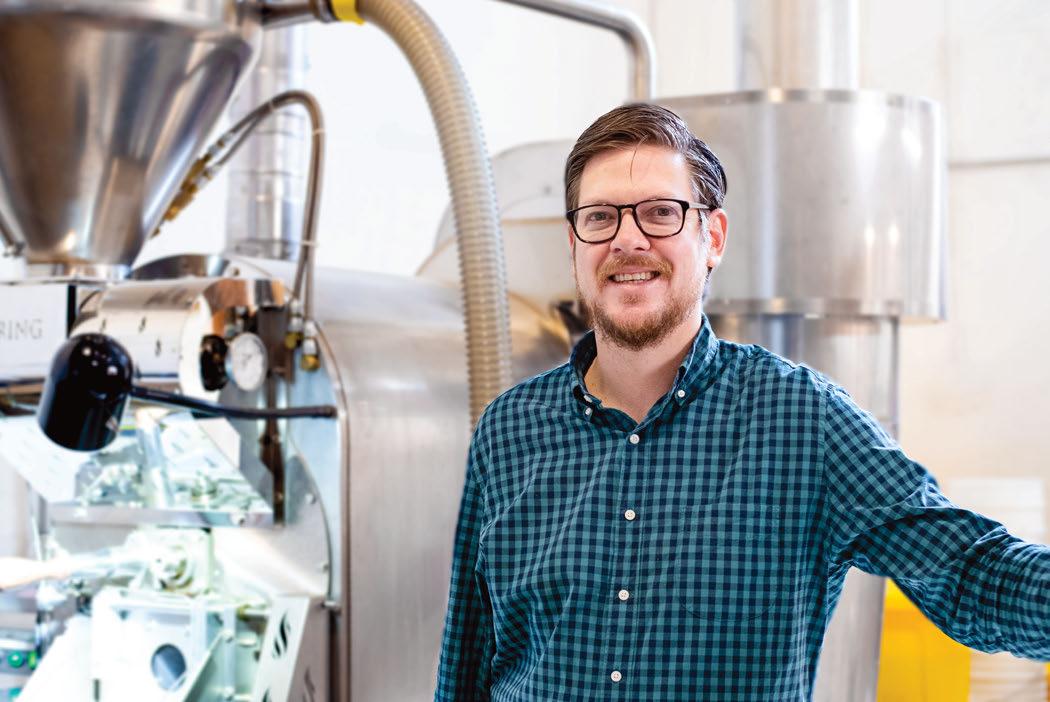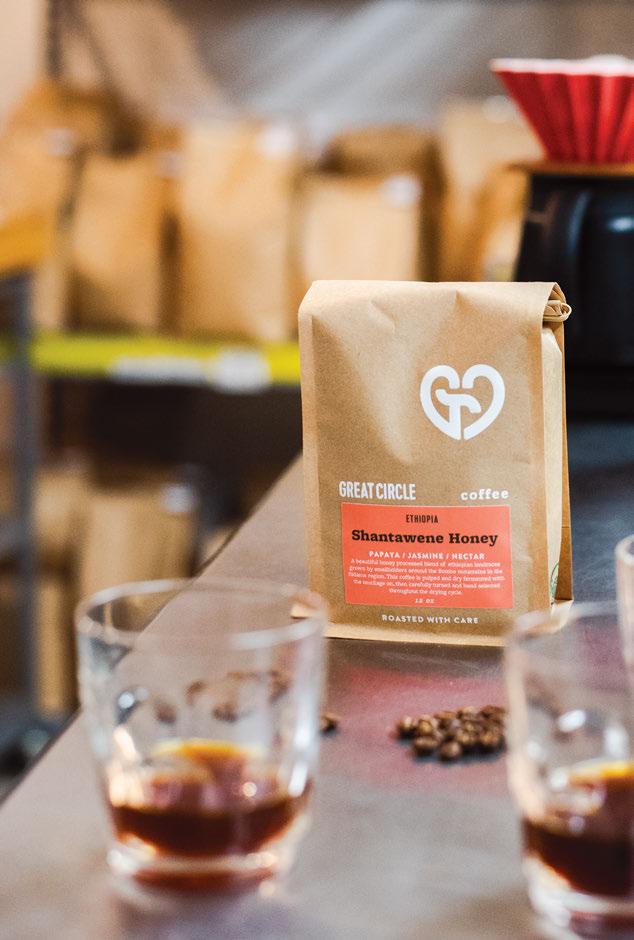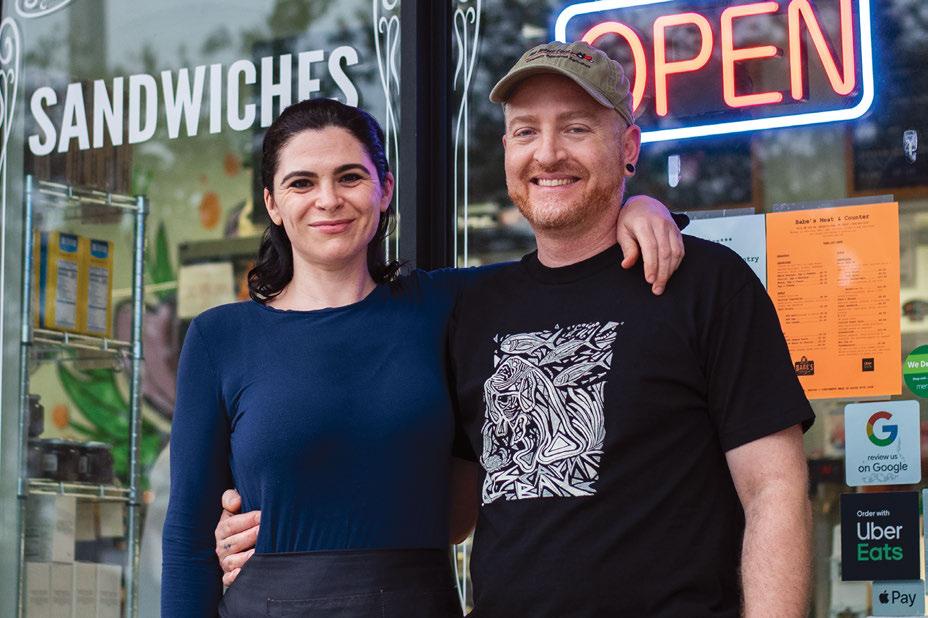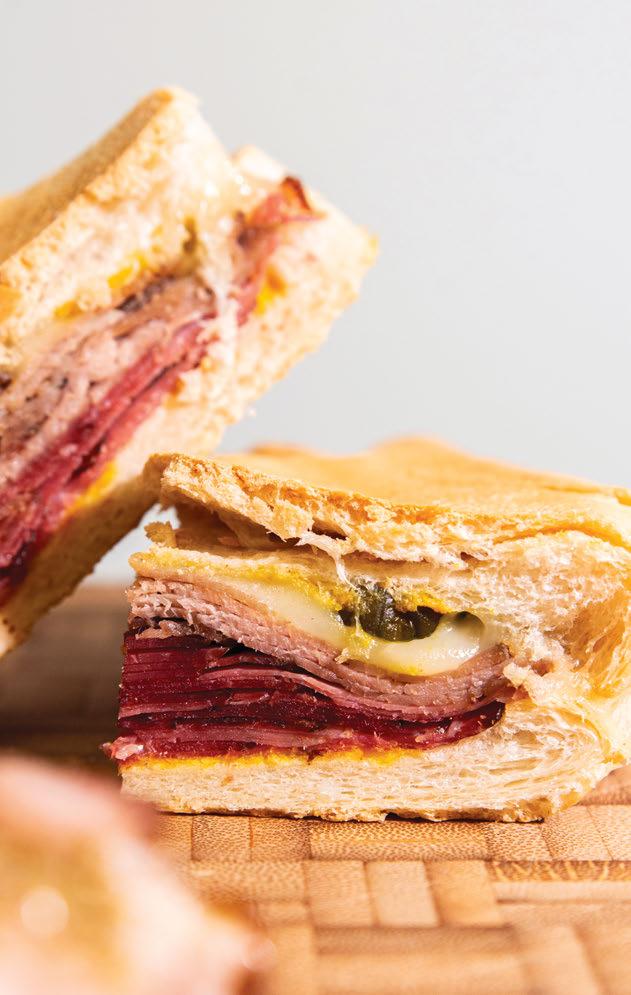
13 minute read
ROASTER
WARREN JACLYN PHOTOS:
Sergio Boppel
Advertisement
GREAT CIRCLE COFFEE
Sergio Boppel was born in Guatemala, the land of full-bodied co ee beans grown on farms so green that they almost hurt to look at. His great-grandfather was a co ee farmer, and although Boppel moved to Brussels at age 14, his uncle and cousin continued the legacy of growing and harvesting high-quality co ee. Boppel studied chemical engineering at Purdue University and got an MBA from Babson College in 2007 before working in engineering and nance for more than a decade. But in 2015, Boppel and his wife, Carolina Jaar, invested in their own idea: a co ee company with the vision to make a positive impact in every step of the supply chain. ey loved Miami, where they had family, and knew the city had a particular appreciation for co ee, though there wasn’t a large variety in the specialty category. But Boppel doesn’t mind sharing stories with customers about co ee regions, farmers, suppliers, and all the ecological factors that can make co ee production sustainable. In 2016, he started roasting in his own Little Haiti space and grew his wholesale model with restaurants, co ee shops, bakeries, and hotels as clients. Today, Great Circle Co ee retails precisely roasted, sustainably sourced co ees from around the world, including some from Boppel’s uncle’s farm in Guatemala. seboppel / greatcirclecoffee
Favorite roasting resource: My friends in the industry
Co ee region you're most excited about:
Guatemala and Ethiopia Co ee trend you’d like to see: Although I love espresso, more lter co ee! How you brew co ee at home: Currently with an Origami Dripper Advice to your younger self: ink long term.
Great Circle's Ethiopia Shantawene Honey Process Co ee FROM START TO FINISH
1is co ee’s story begins in the Bensa, Sidama region of Ethiopia in Shantawene Village. In most parts of the world, co ee trees are planted in nurseries and transferred to the eld, but in Ethiopia, they grow in the wild. “It’s the birthplace of co ee,” Great Circle Co ee owner Sergio Boppel says. “ ere are forests that grow naturally, and most co ee there is de facto organic.” Because of limited resources, many Ethiopian co ee farmers rely on organic, natural materials rather than expensive and di cult-tosource fertilizers and pesticides. 2 Once the co ee seed germinates and is planted, it takes up to six years for the co ee tree to grow and bear enough fruit for harvest. e co ees are grown at a high elevation and, when the co ee cherries are ripe enough, picked by hand.
3e cherries are then treated to a honey process, which is a hybrid of the fully washed and dry processes. Co ee farmers will depulp the seeds, leaving some of their sticky mucilage on, then lay them on drying tables. Once the cherries reach the desired humidity level, they enter a drying mill that dehulls a second layer, called parchment, from the seeds. 4 e seeds are sorted and separated by size and density. “ e goal is to provide more uniform co ee beans because at the end, you want them all to roast the same way,” Boppel says. 5 roughout the entire process, co ee farmers are plucking out defective seeds. Discolored seeds are out. Insect-damaged seeds are out. Seeds that oat in water (meaning they’re insu ciently dense) are out. Boppel says, “ e big picture message is that there is a lot of human work involved in high-quality co ee.”
6Here’s where the co ee buyer comes in. For this co ee, Boppel works with Portland-based supplier Catalyst, which has a lot of experience in Ethiopia. “ e closer you are to the people, the more you’re able to play a role, the better the quality,” Boppel says. e supplier takes samples by roasting and tasting di erent cuts of co ee before deciding on a batch to export. 7 e co ee is shipped to Catalyst by way of Houston. Catalyst samples it once more upon arrival, assuring that its quality survived the travel, before it makes its way to Great Circle Co ee’s roastery by truck. 8 Once it arrives, Boppel begins experimenting with his roaster—he calls it “pro ling the co ee.” “As we’re roasting, we’re seeing how the co ee behaves under di erent applications of heat and taking samples, and we end up choosing a pro le that we like best,” says Boppel. Since the honey process seeds are extremely uniform in size, shape, and their high density, Boppel is able to roast them hot and fast in under 10 minutes. “Our goal is to not in uence the taste of the seed or the avor,” he says. “We want the natural avors to shine through.” 9 Boppel recommends that his Shantawene Honey Process co ee is brewed as a pourover using a paper lter, which is “probably the best way to get a lot of avor clarity out of this co ee.” He says, “You may sacri ce some of the body, but you remove a lot more of the sediment.” e resulting co ee is aromatic, bright, and intense with notes of jasmine, stone fruit, and papaya.

WARREN PHOTO:JACLYN

Jason and Melanie Schoendorfer
BABE'S MEAT & COUNTER
Melanie Schoendorfer’s Italian grandparents made all kinds of meat products from scratch in Canada—prosciutto, pepperettes, Italian sausage. Her family, plus 11 years of experience at a gourmet grocery, Joanna's Marketplace, gave her a solid appreciation for butchery. ( e woman does hotdog-eating competitions!) Her husband, Jason, started in audio engineering and spent more than a decade with the family business, a pet cemetery and crematory. e two met at the Starbucks where Jason worked while studying; Melanie had a job at the Canada Pavilion at Disney World’s Epcot Center. ey both enjoyed a good sausage but couldn’t nd any they liked once they moved to Miami. Neither had formal butchery training, so they began experimenting at Joanna’s in 2013, starting with sausage and bacon then simple sandwiches, and selling at Pinecrest Gardens Farmers Market. In 2018, they jumped into Babe’s Meat & Counter fulltime. e Schoendorfers increased to four farmers markets per week, secured a commercial kitchen, and worked seven days a week for years. When COVID-19 hit, grocery stores couldn’t keep meat in stock, and Babe’s demand exploded. In addition to their house-smoked and -cured meats, the Schoendorfers now push out Cuban sandwiches, Montrealstyle smoked meat, roast pork, cheesesteaks, and carefully made sausages. thatdumbfacesausagehag / elpandeyayson / babefroman305
Jason
Favorite kitchen tool: Spatula Tool you wish you had: Band saw Favorite cookbook: Louisiana Real & Rustic by Emeril Lagasse Advice to your younger self: Worry about quality of work before speed. Speed will come with repetition.
Melanie
Favorite kitchen tool: Tie knife or sausage prick Tool you wish you had: Bu alo chopper Favorite cookbook: Great Sausage Recipesand Meat Curing by Rytek Kutas Most important kitchen rule: Keep hair tied up and covered. Advice to your younger self: Always pay attention when with others who are more experienced.

METHOD
For the Smoked Ham:
In a large pot, bring salts, sugar, and 1 gallon water to a simmer. Place all remaining ingredients in a large, nonreactive container. Add hot liquid and stir to combine. Allow to cool, preferably overnight. e following day, using a brine injector, pump ham with brine, then fully submerge in brine. Allow ham to sit 4 to 10 days, overhauling every 2 days. Rinse hams, transfer to walk-in, and let cool overnight. e following day, smoke at 150°F with fruit wood until internal temperature reaches 150°F. Let cool overnight, uncovered. Using a deli slicer, thinly slice ham. Portion out 2.5-ounce portions; reserve.
For the Italian Roast Pork:
In a large mixing bowl, combine salt, peppers, herbs, and spices. Rub pork shoulder with spice mix, making sure the surface and all parts are well-coated. Loosely cover, transfer to walk-in, and let sit overnight. e following day, preheat oven to 225°F. Set pork shoulder in a roasting pan over a bed of onions. Roast, covered, about 2½ hours or until internal temperature reaches 150°F. Separate pork from juices, transferring juices to a nonreactive container to reserve. Let pork cool completely. Using a deli slicer, thinly slice pork shoulder. Portion out 2.5-ounce portions; reserve.
For the Curry Bread & Butter Pickles:
In a large, nonreactive container, combine cucumbers and salt; mix gently but thoroughly. Let rest in walk-in 1 to 2 hours. In a medium pot, add remaining ingredients and bring to a simmer, stirring to incorporate. Meanwhile, rinse cucumbers, then return them to the nonreactive container. Pour hot brine over cucumbers and mix well. Allow to rest overnight in walk-in. e following day, distribute to quart containers, making sure to submerge pickles in brine.
For the Yellow Mustard:
In a tall half pan, add dry ingredients and whisk to combine. Add vinegar and 1.5 kilograms water and mix thoroughly. Transfer mixture to a saucepan over medium-low heat and bring to a simmer. Continue to simmer 5 to 10 minutes or until desired thickness is reached.
To Assemble and Serve:
Butter the inside of both bread halves, then griddle butter-side-down until golden brown. Meanwhile, throw one portion of Italian Roast Pork onto a at-top and add several spoonfuls of reserved pork juices. Top with cheese and continue to cook until cheese begins to melt.
Spread a light amount of Yellow Mustard on the inside of both bread halves. On one half, layer 1 portion Smoked Ham, warm Italian Roast Pork with cheese, then 5 to 6 Curry Bread & Butter Pickles. Top it with other bread half. Transfer the whole sandwich to the at-top and press with a steak weight. Flip to nish both sides. Slice in half and serve hot.
Cuban sandwich
Butchers Jason and Melanie Schoendorfer of Babe’s Meat & Counter Adapted by StarChefs
INGREDIENTS
Smoked Ham:
Yield: 1 ham 1½ cups salt 8 teaspoons pink curing salt 2 cups brown sugar 1 teaspoon crushed red pepper ½ teaspoon black peppercorns 10 bay leaves 1 teaspoon fennel seeds 2 tablespoons thyme 1 tablespoon garlic powder 4 cloves garlic 1 onion, quartered 1 Niman Ranch ham
Italian Roast Pork:
Yield: 1 pork shoulder 540 grams salt 80 grams ground black pepper 36 grams crushed red pepper 20 grams dried rosemary 20 grams dried thyme 200 grams garlic powder 24 grams of oregano 120 grams ground fennel seed 40 grams ground cumin 1 Niman Ranch pork shoulder 6 to 8 onions, halved
Curry Bread & Butter Pickles:
Yield: 1 batch 12 seedless cucumbers, sliced on a mandoline 9 tablespoons salt 1.35 kilograms white sugar 1.1 kilograms white vinegar 640 grams apple cider vinegar 230 grams brown sugar 80 grams mustard seeds 8 grams celery seeds 8 grams curry powder 8 grams crushed red pepper
Yellow Mustard:
1.2 kilograms mustard powder 54 grams salt 20 grams turmeric powder 16 grams garlic powder 8 grams paprika 1.5 kilograms apple cider vinegar
To Assemble and Serve:
Yield: 1 sandwich Butter 6-inch piece of Cuban bread, halved lengthwise Swiss cheese









Two wine industry underdogs now host the most talked-about wine club in Miami—without spending a cent of their own money.
by Erin Lettera
When BFFs Macarena Carrillo and Mariel Dalmau were preparing and pouring until the wine ran out. With each event, attendance for their introduction to the Court of Master Sommeliers, they for their introduction to the Court of Master Sommeliers, they morphed from an industry crowd to a larger, more diverse mix. would often fi nd themselves at corporate wine tastings would often fi nd themselves at corporate wine tastings feeling like the underdogs. Instead of being educated, COVID-19 altered the whole model of Grape Crush. Tastings went the young women were treated as though they didn’t from a ticketed to à la carte format so guests could choose who to sit belong and questioned for their tastes. So they brought with and for how long. “This was the major shift for Grape Crush,” together a group of like-minded friends for a wine study Dalmau says. “We have found major success in this new format that club where they could taste, talk, and share without club where they could taste, talk, and share without it's now almost like a barrier to have it be ticketed.” judgement. “Wine is so steeped in history, it’s a neverjudgement. “Wine is so steeped in history, it’s a neverending hunt for knowledge,” Carrillo says. ending hunt for knowledge,” Carrillo says. It was a big change from the early days, when the somms limited themselves to three wines and took on all the risk. But with à la carte, As they continued to learn, they realized that Miami’s nightlife scene they do the purchasing through the hosting businesses. Carrillo was stifl ing the progression of local wine culture. “You go to a bar, and Dalmau send a list of up to nine wines and build relationships crush a few shots, then head to the clubs and get bottle service,” between the hosts and small distributors. Carrillo says. “Miami also doesn’t have any ‘wine country,’ so the wine culture here is forced to be very traditional.” But with the growth “The more places we do it, the more natural wines we put on their of non-Miami natives moving down to open restaurants, more of a lists, the more people come back looking for it, so it increases the demand exists for unusual wines. demand for natural wine,” Dalmau says. During a shift at Fooq’s restaurant, where they both worked as She and Carrillo are aware of the fact that the natural wine sommeliers, “Maca and Mari” got to talking about expanding their movement comes with its own set of pretentiousness, similar to what wine club. The playful conversation evolved into a fl yer and an they faced early on in their careers. “No matter the level of expertise idea centered around raw wine. Using Fooq’s as their fi rst location, or certifi cations we have, if you like it, then it’s a good wine,” Carrillo Grape Crush by Natty Times launched as a ticketed event for about says. They vow to continue doing what they do, letting 30 people. It wasn’t a money-maker, just a place for them to practice people know that wine is subjective, wine is exciting, and and share their knowledge. Totally winging it, they poured a wine is a never-ending learning process. crémant, alpine nebbiolo, and rosado txakolina and just kept pouring
to learn more!
they faced early on in their careers. “No matter the level of expertise or certifi cations we have, if you like it, then it’s a good wine,” Carrillo says. They vow to continue doing what they do, letting people know that wine is subjective, wine is exciting, and










